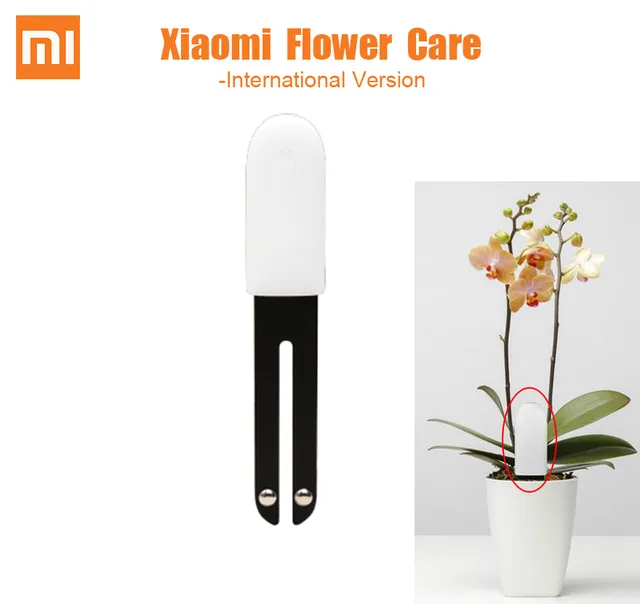A simple Linux python script to query arbitrary Mi Bluetooth sensor devices and send the data to an MQTT broker, e.g., the famous Eclipse Mosquitto. After data made the hop to the MQTT broker it can be used by home automation software, like openHAB or Home Assistant.
The program can be executed in daemon mode to run continuously in the background, e.g., as a systemd service.
- Xiaomi Mi Flora sensors (e.g. 12-17€) are meant to keep your plants alive by monitoring soil moisture, soil conductivity and light conditions
- The sensor uses Bluetooth Low Energy (BLE) and has a rather limited range
- A coin cell battery is used as power source, which should last between 1.5 to 2 years under normal conditions
- Food for thought: The sensor can also be used for other things than plants, like in the fridge or as door and blind sensor
- ''Xiaomi Mijia Temperature and Humidity Sensor'' (e.g. $13) are for monitoring indoor air temperature and humidity
- The sensor uses Bluetooth Low Energy (BLE) and has a rather limited range
- Weight: 43 g
- Screen size: 1.78 inch
- Temperature range: -9.9°C-60°C
- Humidity range: 0~99.9%
- Rated power: 0.18 mW
- Powered By: Battery (AAA)
- Tested with Mi Flora firmware v2.6.2, v2.6.4, v2.6.6, v3.1.4, others anticipated
- Tested with Xiaomi Mijia Temperature and Humidity Sensor (MJ_HT_V1) firmware v00.00.66
- Build on top of open-homeautomation/miflora and mitemp_bt
- Highly configurable
- Data publication via MQTT
- Configurable topic and payload:
- JSON encoded
- following the Homie Convention v2.0.5
- following the mqtt-smarthome architecture proposal
- using the HomeAssistant MQTT discovery format
- using the ThingsBoard.io MQTT interface
- following the Wiren Board MQTT Conventions
- Announcement messages to support auto-discovery services
- MQTT authentication support
- No special/root privileges needed
- Daemon mode (default)
- Systemd service, sd_notify messages generated
- MQTT-less mode, printing data directly to stdout/file
- Automatic generation of openHAB items and rules
- Reliable and intuitive
- Tested on Raspberry Pi 3 and Raspberry Pi 0W
- Wiren Board 5 (Debian Stretch)
The Mi Flora sensor offers the following plant and soil readings:
| Name | Description |
|---|---|
temperature |
Air temperature, in [°C] (0.1°C resolution) |
light |
Sunlight intensity, in [lux] |
moisture |
Soil moisture, in [%] |
conductivity |
Soil fertility, in [µS/cm] |
battery |
Sensor battery level, in [%] |
The Xiaomi Mijia Temperature and Humidity Sensor offers the following readings:
| Name | Description |
|---|---|
temperature |
Air temperature, in [°C] (0.1°C resolution) |
humidity |
Air humidity in [%] |
battery |
Sensor battery level, in [%] |
An MQTT broker is needed as the counterpart for this daemon. Even though an MQTT-less mode is provided, it is not recommended for normal smart home automation integration. MQTT is huge help in connecting different parts of your smart home and setting up of a broker is quick and easy.
On a modern Linux system just a few steps are needed to get the daemon working.
The following example shows the installation under Debian/Raspbian below the /opt directory:
sudo apt install git python3 python3-pip bluetooth bluez
git clone https://github.com/ThomDietrich/miflora-mqtt-daemon.git /opt/miflora-mqtt-daemon
cd /opt/miflora-mqtt-daemon
sudo pip3 install -r requirements.txtThe daemon depends on gatttool, an external tool provided by the package bluez installed just now.
Make sure gatttool is available on your system by executing the command once:
gatttool --helpTo match personal needs, all operation details can be configured using the file config.ini.
The file needs to be created first:
cp /opt/miflora-mqtt-daemon/config.{ini.dist,ini}
vim /opt/miflora-mqtt-daemon/config.iniAttention: You need to add at least one sensor to the configuration. Scan for available Mi Bluetooth sensors in your proximity with the command:
sudo hcitool lescanInterfacing your Mi Bluetooth sensor with this program is harmless. The device will not be modified and will still work with the official Xiaomi app.
A first test run is as easy as:
python3 /opt/miflora-mqtt-daemon/miflora-mqtt-daemon.pyWith a correct configuration the result should look similar to the the screencap above. Pay attention to communication errors due to distance related weak BLE connections.
Using the command line argument --config, a directory where to read the config.ini file from can be specified, e.g.
python3 /opt/miflora-mqtt-daemon/miflora-mqtt-daemon.py --config /opt/miflora-configThe extensive output can be reduced to error messages:
python3 /opt/miflora-mqtt-daemon/miflora-mqtt-daemon.py > /dev/nullYou most probably want to execute the program continuously in the background. This can be done either by using the internal daemon or cron.
Attention: Daemon mode must be enabled in the configuration file (default).
-
Systemd service - on systemd powered systems the recommended option
sudo cp /opt/miflora-mqtt-daemon/template.service /etc/systemd/system/miflora.service sudo systemctl daemon-reload sudo systemctl start miflora.service sudo systemctl status miflora.service sudo systemctl enable miflora.service -
Screen Shell - Run the program inside a screen shell:
screen -S miflora-mqtt-daemon -d -m python3 /path/to/miflora-mqtt-daemon.py
A Dockerfile in the repository can be used to build a docker container from the sources with a command such as:
docker build -t miflora-mqtt-daemon .Running the container in interactive mode works like this:
docker run -it --name miflora-mqtt-daemon -v .:/config miflora-mqtt-daemonTo run the container in daemon mode use -d flag:
docker run -d --name miflora-mqtt-daemon -v .:/config miflora-mqtt-daemonThe /config volume can be used to provide a directory on the host which contains your config.ini file (e.g. the . in the above example could represent /opt/miflora-mqtt-daemon).
You may need to tweak the network settings (e.g. --network host) for Docker depending on how your system is set up.
In the "mqtt-json" reporting mode, data will be published to the MQTT broker topic "miflora/sensorname" (e.g. miflora/petunia, names configurable).
An example:
{"light": 5424, "moisture": 30, "temperature": 21.4, "conductivity": 1020, "battery": 100}This data can be subscribed to and processed by other applications, like openHAB.
Enjoy!
To make further processing of the sensor readings as easy as possible, the program has an integrated generator for openHAB Items definitions. To generate a complete listing of Items, which you can then copy and adapt to your openHAB setup, execute:
python3 /opt/miflora-mqtt-daemon/miflora-mqtt-daemon.py --gen-openhabThe following code snippet shows a simple example of how a Mi Flora openHAB Items file could look like for the above example:
// miflora.items
// Mi Flora specific groups
Group gBattery "Mi Flora sensor battery level elements" (gAll)
Group gTemperature "Mi Flora air temperature elements" (gAll)
Group gMoisture "Mi Flora soil moisture elements" (gAll)
Group gConductivity "Mi Flora soil conductivity/fertility elements" (gAll)
Group gLight "Mi Flora sunlight intensity elements" (gAll)
// Mi Flora "Big Blue Petunia" (C4:7C:8D:60:DC:E6)
Number Balcony_Petunia_Battery "Balcony Petunia Sensor Battery Level [%d %%]" <text> (gBalcony, gBattery) {mqtt="<[broker:miflora/petunia:state:JSONPATH($.battery)]"}
Number Balcony_Petunia_Temperature "Balcony Petunia Air Temperature [%.1f °C]" <text> (gBalcony, gTemperature) {mqtt="<[broker:miflora/petunia:state:JSONPATH($.temperature)]"}
Number Balcony_Petunia_Moisture "Balcony Petunia Soil Moisture [%d %%]" <text> (gBalcony, gMoisture) {mqtt="<[broker:miflora/petunia:state:JSONPATH($.moisture)]"}
Number Balcony_Petunia_Conductivity "Balcony Petunia Soil Conductivity/Fertility [%d µS/cm]" <text> (gBalcony, gConductivity) {mqtt="<[broker:miflora/petunia:state:JSONPATH($.conductivity)]"}
Number Balcony_Petunia_Light "Balcony Petunia Sunlight Intensity [%d lux]" <text> (gBalcony, gLight) {mqtt="<[broker:miflora/petunia:state:JSONPATH($.light)]"}Paste the presented items definition into an openHAB items file and you are ready to go. Be sure to install the used MQTT Binding and JSONPath Transformation openHAB addons beforehand.
to integrate with ThingsBoard.io:
- in your
config.inisetreporting_method = thingsboard-json - in your
config.iniassign unique sensor names for your plants - on the ThingsBoard platform create devices and use
Access tokenasCredential typeand the chosen sensor name as token
to integrate with Wiren Board in your config.ini set:
reporting_method = wirenboard-mqtt- set
hostnamewith address of Wiren Board controller and optionallyusernameandpassword
sensors will automatically appear on Wiren Board as separate devices
Xiaomi and Mi Flora are registered trademarks of BEIJING XIAOMI TECHNOLOGY CO., LTD.
This project is a community project not for commercial use. The authors will not be held responsible in the event of device failure or withered plants.
This project is in no way affiliated with, authorized, maintained, sponsored or endorsed by Xiaomi or any of its affiliates or subsidiaries.


